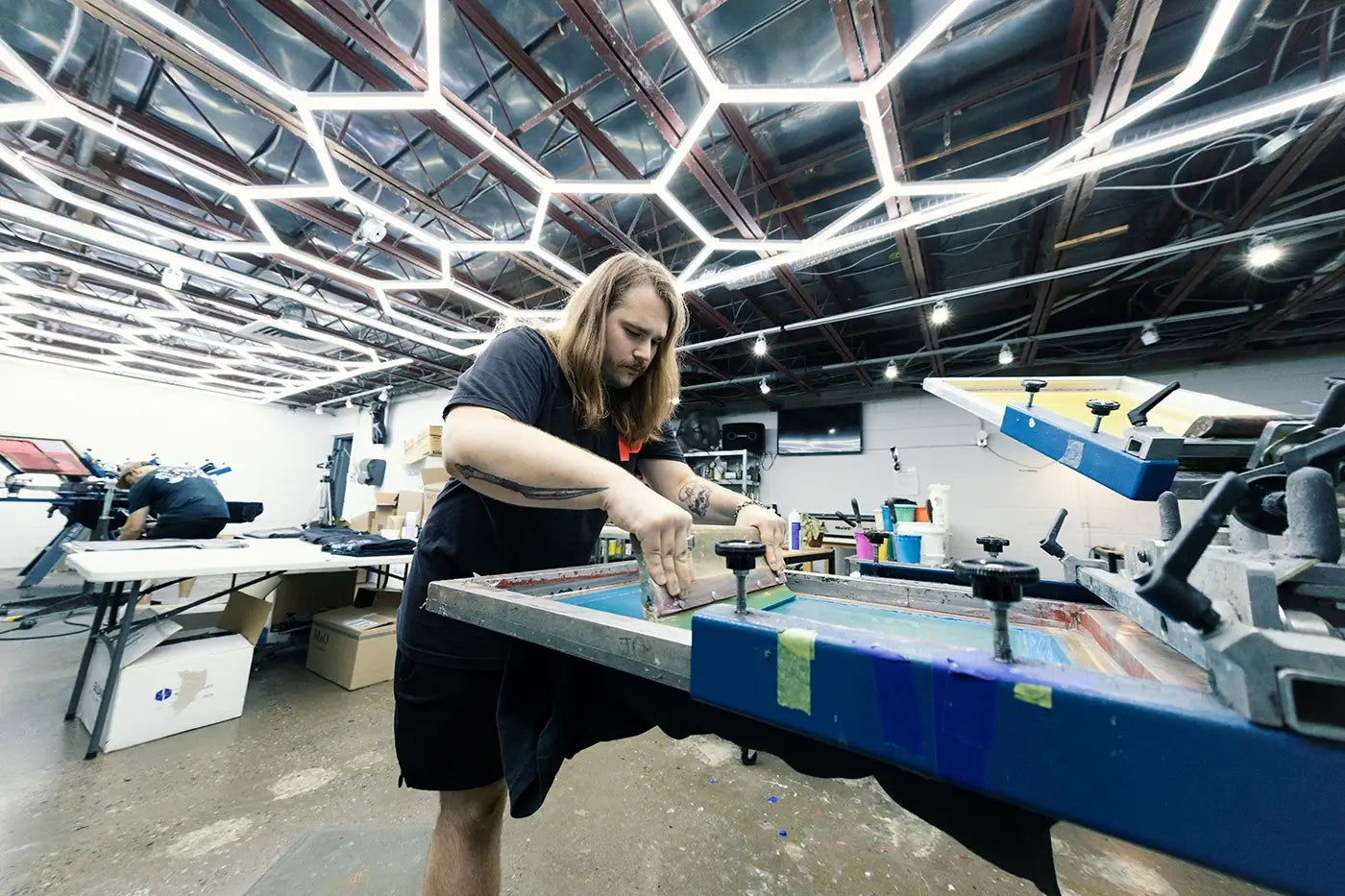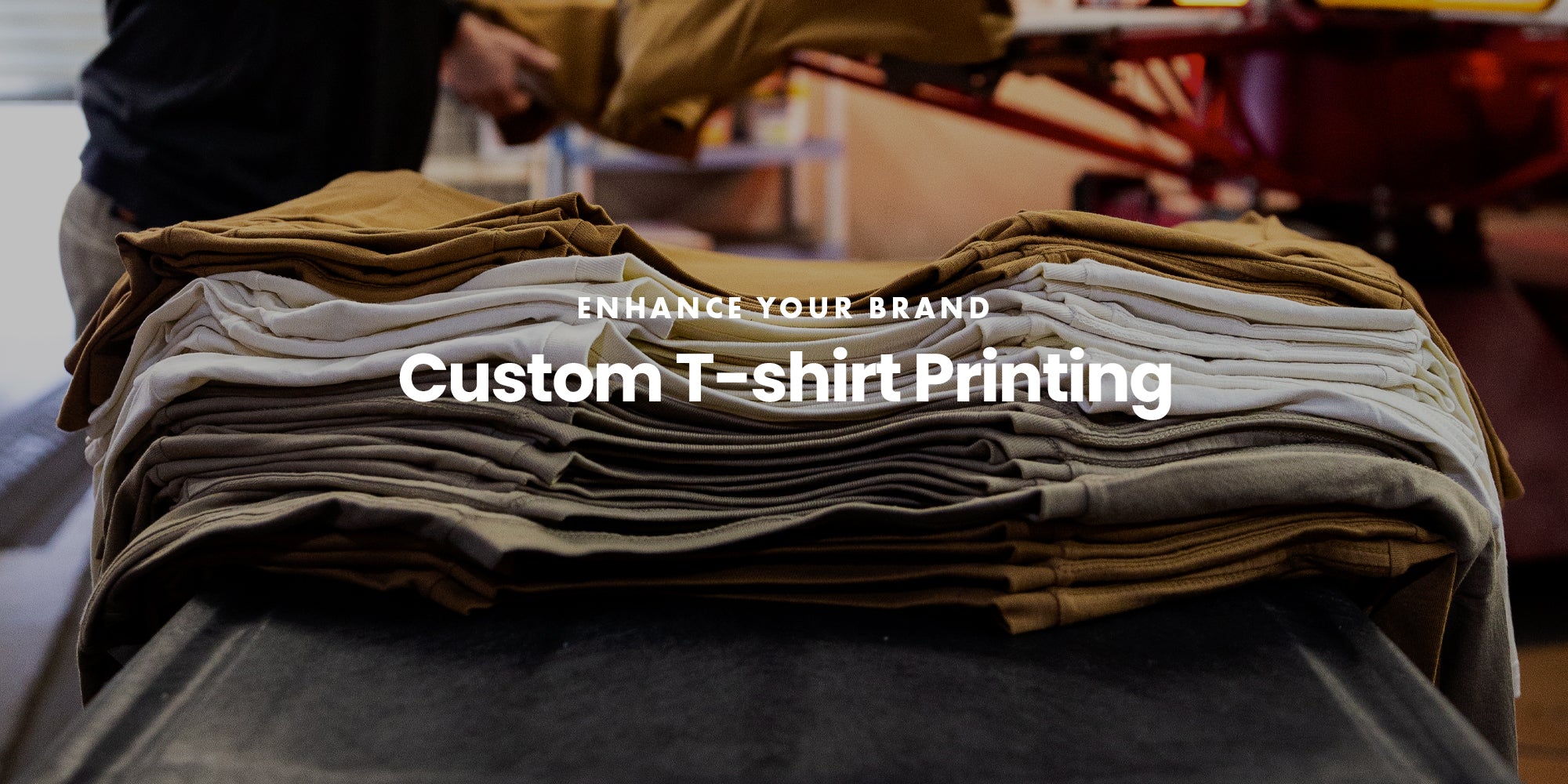Best Local T-Shirt Printing for Personalized Apparel
Best Local T-Shirt Printing for Personalized Apparel
Blog Article
Screen Printing Uncovered: Every Little Thing You Need to Find Out About Tee Shirt and Garment Printing Techniques
If you've ever questioned exactly how those dynamic layouts finish up on your favored tees, you remain in the best area. Screen printing is a remarkable method that integrates art with strategy, using endless possibilities for imagination. Comprehending the fundamentals, from equipment to ink selections, can substantially influence your outcomes. All set to discover the vital components that make display printing an art type? Let's reveal the information that can elevate your tasks.
The Fundamentals of Screen Printing: Just How It Functions
When you plunge right into display printing, you'll discover it's both an art and a scientific research. At its core, screen printing involves developing a stencil, or display, that enables ink to go through only in details areas (screen printing kit). You start by selecting your layout and preparing your display with a light-sensitive solution. As soon as you reveal this solution to light, it hardens, leaving your layout as an unfavorable room.
Following, you'll mix your inks and prepare your printing surface area. Placement the screen over the material, after that use a squeegee to press ink via the display onto the garment. This process calls for precision, as you want clear, dynamic prints. After printing, you'll heal the ink with warmth, guaranteeing it complies with the material and lasts through cleans. Each action is necessary, and mastering them will certainly boost your display printing abilities, changing simple garments right into distinct, expressive pieces.
Types of Display Printing Techniques
As soon as you understand the essentials of screen printing, it's time to check out the numerous methods that can raise your layouts. One popular method is typical display printing, where ink is pushed via a stenciled display. This technique is terrific for vibrant, vivid colors. After that there's water-based ink printing, which uses a softer feeling and is green, however it needs a different technique to treating.
An additional choice is plastisol printing, known for its resilience and dazzling shades, making it a preferred for many brands. Experiment with halftone printing to create slope impacts and intricate styles.
Necessary Equipment for Screen Printing
To achieve magnificent results in display printing, having the ideal tools is fundamental. First, you'll need a tough screen printing structure, which holds the mesh that transfers your design onto the garment. Next off, invest in premium squeegees; these are vital for using ink uniformly across the display. You'll additionally need an excellent exposure device to produce your displays, along with a washout cubicle for cleansing them after usage. A dependable heat source, like a conveyor dryer or heat press, is critical for healing your prints to assure long life. Don't forget an appropriate work area, outfitted with tables and storage space for your materials. Safety gear, such as masks and handwear covers, will certainly maintain you risk-free from chemicals and inks. With the right devices, you'll be well on your means to creating professional-quality prints.
Picking the Right Inks and Materials
When selecting inks and materials for screen printing, you require to think about the kind of ink that works ideal for your job. Assume concerning material compatibility to assure your styles look last and wonderful lengthy. Likewise, discover environmentally friendly ink alternatives to make your printing procedure extra lasting.
Types of Screen Inks
Selecting the ideal display ink is important for attaining vibrant, resilient prints that meet your project's demands. There are a number of types of display inks to check out. Plastisol ink is prominent for its flexibility and ease of usage, offering excellent shade opacity on dark fabrics. Water-based ink, on the various other hand, provides a softer feeling and is eco-friendly, making it excellent for those aiming to lessen their environmental influence. Discharge inks get rid of dye from the textile, leading to a soft, vintage appearance but need specific handling. Specialty inks, such as glow-in-the-dark or metallic, can include unique impacts to your designs. Examine your task demands and pick the ink that straightens ideal with your preferred end result.

Textile Compatibility Factors To Consider
Comprehending fabric compatibility is essential for accomplishing top quality display prints, particularly given that different products react distinctly to various inks. Always check your inks on example material to guarantee they stick correctly and keep color honesty. Furthermore, keep in mind that textile weight and texture can influence the final result, so picking the right ink and product combination is essential for your job's success.
Eco-Friendly Ink Options
Environmentally friendly inks are coming to be a popular option for display printers that wish to lessen their ecological impact while maintaining high quality. When picking inks, consider water-based inks, which are less unsafe and simpler to tidy up contrasted to traditional solvents. These inks bond well with materials, supplying vivid results without harmful chemicals. You may additionally explore eco-solvent inks that use fewer unstable natural compounds (VOCs), making them a safer choice for both your health and wellness and the earth.
In Continue addition, search for inks made from renewable sources, such as soy or vegetable-based alternatives. By picking the appropriate inks and products, you'll not just produce sensational styles however additionally add to an extra lasting printing process. Make the switch, and your prints will reflect your dedication to the setting!
Preparing Your Style for Screen Printing

File Layout Demands
To guarantee your style looks sharp and vibrant on fabric, you'll require to pay attention to submit style needs for screen printing. Beginning with vector files like AI or EPS, as they can be scaled without losing top quality. If you utilize raster images, go with high-resolution documents, such as TIFF or PNG, ideally at 300 DPI. Stay clear of using JPEGs, as they can lose quality when resized. Likewise, see to it your design has a transparent history to avoid undesirable white edges on your prints. Finally, keep color settings in mind; CMYK is basic for display printing, so transform your RGB makes as necessary. By adhering to these standards, you'll set your artwork up for a successful print.
Shade Splitting Up Strategies
Color splitting up is a vital step in preparing your layout for screen printing, and understanding it can substantially improve your print top quality. You'll need to try here damage your style right into private colors, as each color calls for a different display throughout printing. This precision not just guarantees accurate shade depiction however likewise enhances the printing process.
Resolution and Dimension
Accomplishing the very best results in display printing starts with ensuring your design has the ideal resolution and size. Ideally, your art work should go to least 300 DPI (dots per inch) for sharp, clear prints. Your last product may look unprofessional and pixelated. if you utilize lower resolution.
When it pertains to size, think about the measurements of your print area. Layout your artwork to match the final print size, ideally developing it in the real measurements you'll be printing. In this manner, you'll prevent any kind of unforeseen scaling problems.
Always inspect your style in both vector and raster layouts. Vector graphics can be scaled without shedding high quality, making them ideal for screen printing. Preparing properly will assure your design looks outstanding on every garment!
Step-by-Step Display Printing Refine
Screen printing is a dynamic procedure that permits you to produce lively designs on numerous surface areas. To obtain started, you'll require a display, emulsion, and your selected ink.
After washing out the unexposed solution, your display prepares. Set it up on your printing surface area and straighten your garment under it. Pour ink onto the screen and make use of a squeegee to push the ink with the stencil onto the textile. Raise the display thoroughly and allow the print dry. Lastly, treat the ink using warmth to assure longevity. That's it! You've effectively display published your design.
Tips for Successful Display Printing Projects
While you're diving right into your screen printing jobs, bear in mind that preparation is vital to success. Start by collecting all your materials-- inks, garments, displays, and squeegees. A clean office assists avoid unwanted errors, so neat up prior to you begin.
Following, verify your art work is high-resolution and correctly sized for your garment. Examine your display for appropriate exposure and clean it completely to avoid smudges. When mixing your inks, comply with the manufacturer's standards to achieve the ideal uniformity.
During printing, use even stress with your squeegee for constant results. Do not rush; take your time to confirm each print fulfills your requirements. After printing, let your garments completely dry totally prior to handling or packaging them.
Last but not least, always maintain an example of your help future referral. By doing my explanation this, you can assess your development and boost your techniques over time. Satisfied printing!

Often Asked Concerns
How much time Does It Require To Set up a Display Printing Job?
Establishing a screen printing job generally takes around thirty minutes to an hour. You'll prepare the screens, mix inks, and readjust journalism. The moment varies based on intricacy and experience, so remain organized!
Can I Publish on Various Textile Enters Making Use Of the Exact Same Strategy?
Yes, you can publish on various fabric kinds utilizing the exact same technique, yet you'll need to readjust your inks and settings. Some textiles take in ink in different ways, so trying out warranties the ideal results for every material.
What Are Common Blunders to Prevent in Display Printing?
When display printing, stay clear of usual errors like utilizing the wrong ink, disregarding correct direct exposure times, or missing pre-press checks. Always evaluate your setup and keep tidy displays to guarantee quality outcomes each time.
Just How Can I Correctly Tidy and Keep My Display Printing Tools?
To appropriately tidy and preserve your display printing tools, you ought to frequently clean screens with ideal solvents, inspect mops for wear, and ensure all tools are kept dust-free and completely dry. Uniformity prevents pricey repairs and boosts efficiency.
Is Screen Printing Eco-friendly Compared to Various Other Techniques?
Display printing can be more ecologically friendly than various other techniques, particularly if you use water-based inks and eco-conscious materials. By selecting lasting products and methods, you minimize waste and decrease your influence on the earth.
Display Printing Uncovered: Whatever You Required to Know Concerning Tee Shirt and Garment Printing Strategies
At its core, screen printing entails developing a pattern, or screen, that permits ink to pass with just in specific areas. Position the screen over the fabric, after that make use of a squeegee to push ink with the display onto the garment. One preferred approach is typical screen printing, where ink is pressed with a stenciled screen.When selecting inks and products for display printing, you need to take right into account the kind of ink that functions best for your job.
Report this page